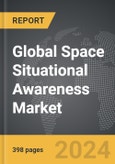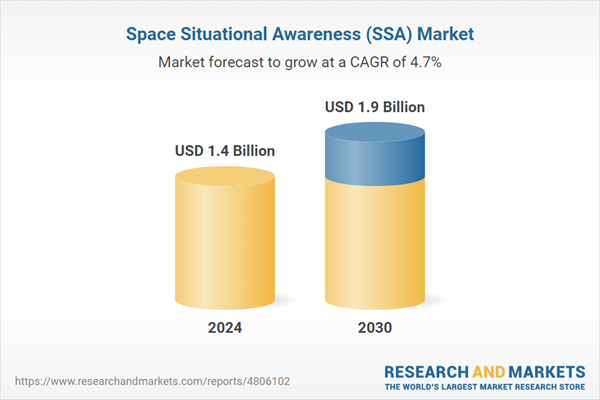The global market for Space Situational Awareness (SSA) was valued at US$1.4 Billion in 2024 and is projected to reach US$1.9 Billion by 2030, growing at a CAGR of 4.7% from 2024 to 2030. This comprehensive report provides an in-depth analysis of market trends, drivers, and forecasts, helping you make informed business decisions. The report includes the most recent global tariff developments and how they impact the Space Situational Awareness (SSA) market.
Segments: Offering (Services, Software); Object (Fragmentation Debris, Non-Functional Spacecrafts, Rocket Bodies, Functional Spacecrafts, Other Objects); End-Use (Government & Military, Commercial).
Geographic Regions/Countries: World; USA; Canada; Japan; China; Europe; France; Germany; Italy; UK; Rest of Europe; Asia-Pacific; Rest of World.
The analysts continuously track trade developments worldwide, drawing insights from leading global economists and over 200 industry and policy institutions, including think tanks, trade organizations, and national economic advisory bodies. This intelligence is integrated into forecasting models to provide timely, data-driven analysis of emerging risks and opportunities.
Global Space Situational Awareness (SSA) Market - Key Trends & Drivers Summarized
What is Space Situational Awareness (SSA) and Why is it Crucial for Modern Space Operations?
Space Situational Awareness (SSA) encompasses the knowledge and monitoring of all objects in Earth's orbit and space environment to predict and avoid potential collisions. As space becomes increasingly congested with satellites, debris from previous missions, and active spacecraft, SSA is essential for maintaining the safety and sustainability of space operations. This field involves tracking objects in orbit, determining their positions and trajectories, and predicting their future paths to mitigate risks associated with space debris and satellite congestion. SSA also plays a crucial role in national security, as it helps to monitor space for potential threats, such as adversarial satellites and other space capabilities. As more nations and private entities venture into space, effective SSA is fundamental to protect assets and ensure the continued viability of space activities.How Are Technological Innovations Advancing SSA Capabilities?
Technological advancements are significantly enhancing the capabilities within SSA. Innovations in radar and optical technologies allow for more precise tracking and characterization of objects in space, regardless of their size or speed. These technologies provide critical data that feeds into algorithms predicting potential collision events or anomalies. Furthermore, artificial intelligence (AI) and machine learning are now being integrated into SSA systems to handle the massive amounts of data more efficiently and with greater accuracy. AI algorithms can quickly analyze patterns and predict changes in space traffic, enhancing decision-making processes. Additionally, the development of autonomous satellite technologies allows spacecraft to perform avoidance maneuvers without direct human intervention, thus increasing responsiveness to potential collisions.What Trends Are Influencing the Development and Importance of SSA?
Several trends are currently shaping the development and increasing importance of SSA. The exponential growth of satellite launches, driven by the decreasing cost of space access and the expansion of global satellite networks, necessitates robust SSA to manage the crowded orbits. This growth includes not only large satellites but also a significant number of small satellites and CubeSats launched in constellations, which are harder to track and manage. There is also a growing international focus on establishing norms and regulations for space traffic management to prevent collisions and ensure a sustainable space environment. Moreover, the commercialization of space, with private companies planning extensive satellite constellations for global internet coverage and other services, puts additional pressure on SSA systems to scale up their capabilities to monitor and manage increased assets effectively.What Drives the Growth of the Space Situational Awareness Market?
The growth in the SSA market is driven by several factors, including the escalating deployment of commercial satellite constellations, increased government spending on space defense and security, and international efforts towards sustainable space management. As companies like SpaceX and OneWeb deploy large numbers of satellites, there is a critical need for enhanced SSA systems to track and manage these assets effectively. Additionally, geopolitical dynamics prompt countries to invest in SSA to safeguard their space assets from potential threats and ensure their strategic interests are protected. Technological innovations that improve the accuracy, speed, and cost-efficiency of SSA systems also fuel market growth, making it feasible to track an ever-increasing number of small and micro-satellites. Furthermore, the growing awareness of space debris issues and the need for active debris removal operations require advanced SSA to identify and mitigate potential collision risks, ensuring long-term sustainability of space activities. These drivers underscore the expanding scope and importance of SSA in facilitating safe and responsible use of outer space.Report Scope
The report analyzes the Space Situational Awareness (SSA) market, presented in terms of units. The analysis covers the key segments and geographic regions outlined below.Segments: Offering (Services, Software); Object (Fragmentation Debris, Non-Functional Spacecrafts, Rocket Bodies, Functional Spacecrafts, Other Objects); End-Use (Government & Military, Commercial).
Geographic Regions/Countries: World; USA; Canada; Japan; China; Europe; France; Germany; Italy; UK; Rest of Europe; Asia-Pacific; Rest of World.
Key Insights:
- Market Growth: Understand the significant growth trajectory of the Services segment, which is expected to reach US$1.3 Billion by 2030 with a CAGR of a 4.9%. The Software segment is also set to grow at 4.3% CAGR over the analysis period.
- Regional Analysis: Gain insights into the U.S. market, valued at $621.3 Million in 2024, and China, forecasted to grow at an impressive 6.5% CAGR to reach $172.5 Million by 2030. Discover growth trends in other key regions, including Japan, Canada, Germany, and the Asia-Pacific.
Why You Should Buy This Report:
- Detailed Market Analysis: Access a thorough analysis of the Global Space Situational Awareness (SSA) Market, covering all major geographic regions and market segments.
- Competitive Insights: Get an overview of the competitive landscape, including the market presence of major players across different geographies.
- Future Trends and Drivers: Understand the key trends and drivers shaping the future of the Global Space Situational Awareness (SSA) Market.
- Actionable Insights: Benefit from actionable insights that can help you identify new revenue opportunities and make strategic business decisions.
Key Questions Answered:
- How is the Global Space Situational Awareness (SSA) Market expected to evolve by 2030?
- What are the main drivers and restraints affecting the market?
- Which market segments will grow the most over the forecast period?
- How will market shares for different regions and segments change by 2030?
- Who are the leading players in the market, and what are their prospects?
Report Features:
- Comprehensive Market Data: Independent analysis of annual sales and market forecasts in US$ Million from 2024 to 2030.
- In-Depth Regional Analysis: Detailed insights into key markets, including the U.S., China, Japan, Canada, Europe, Asia-Pacific, Latin America, Middle East, and Africa.
- Company Profiles: Coverage of players such as Northrop Grumman Corporation, Lockheed Martin Corporation, BAE Systems PLC, Elbit Systems Ltd., European Space Agency and more.
- Complimentary Updates: Receive free report updates for one year to keep you informed of the latest market developments.
Some of the 40 companies featured in this Space Situational Awareness (SSA) market report include:
- Northrop Grumman Corporation
- Lockheed Martin Corporation
- BAE Systems PLC
- Elbit Systems Ltd.
- European Space Agency
- Kratos Defense & Security Solutions, Inc.
- L3Harris Technologies, Inc.
- Airbus Group SE
- Airbus Helicopters, Inc.
- GMV Innovating Solutions SL
- Leidos Holdings, Inc.
- Electro Optic Systems Pty Ltd.
- Kx Systems
- High Earth Orbit Robotics
- Committee for Aviation and Space Industry Development (CASID)
Tariff Impact Analysis: Key Insights for 2025
Global tariff negotiations across 180+ countries are reshaping supply chains, costs, and competitiveness. This report reflects the latest developments as of April 2025 and incorporates forward-looking insights into the market outlook.The analysts continuously track trade developments worldwide, drawing insights from leading global economists and over 200 industry and policy institutions, including think tanks, trade organizations, and national economic advisory bodies. This intelligence is integrated into forecasting models to provide timely, data-driven analysis of emerging risks and opportunities.
What’s Included in This Edition:
- Tariff-adjusted market forecasts by region and segment
- Analysis of cost and supply chain implications by sourcing and trade exposure
- Strategic insights into geographic shifts
Buyers receive a free July 2025 update with:
- Finalized tariff impacts and new trade agreement effects
- Updated projections reflecting global sourcing and cost shifts
- Expanded country-specific coverage across the industry
Table of Contents
I. METHODOLOGYII. EXECUTIVE SUMMARY2. FOCUS ON SELECT PLAYERSIII. MARKET ANALYSISCANADAITALYREST OF EUROPEREST OF WORLDIV. COMPETITION
1. MARKET OVERVIEW
3. MARKET TRENDS & DRIVERS
4. GLOBAL MARKET PERSPECTIVE
UNITED STATES
JAPAN
CHINA
EUROPE
FRANCE
GERMANY
UNITED KINGDOM
ASIA-PACIFIC
Companies Mentioned (Partial List)
A selection of companies mentioned in this report includes, but is not limited to:
- Northrop Grumman Corporation
- Lockheed Martin Corporation
- BAE Systems PLC
- Elbit Systems Ltd.
- European Space Agency
- Kratos Defense & Security Solutions, Inc.
- L3Harris Technologies, Inc.
- Airbus Group SE
- Airbus Helicopters, Inc.
- GMV Innovating Solutions SL
- Leidos Holdings, Inc.
- Electro Optic Systems Pty Ltd.
- Kx Systems
- High Earth Orbit Robotics
- Committee for Aviation and Space Industry Development (CASID)
Table Information
| Report Attribute | Details |
|---|---|
| No. of Pages | 398 |
| Published | April 2025 |
| Forecast Period | 2024 - 2030 |
| Estimated Market Value ( USD | $ 1.4 Billion |
| Forecasted Market Value ( USD | $ 1.9 Billion |
| Compound Annual Growth Rate | 4.7% |
| Regions Covered | Global |









